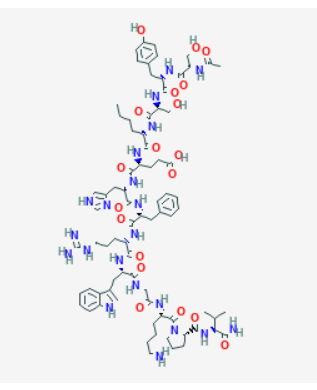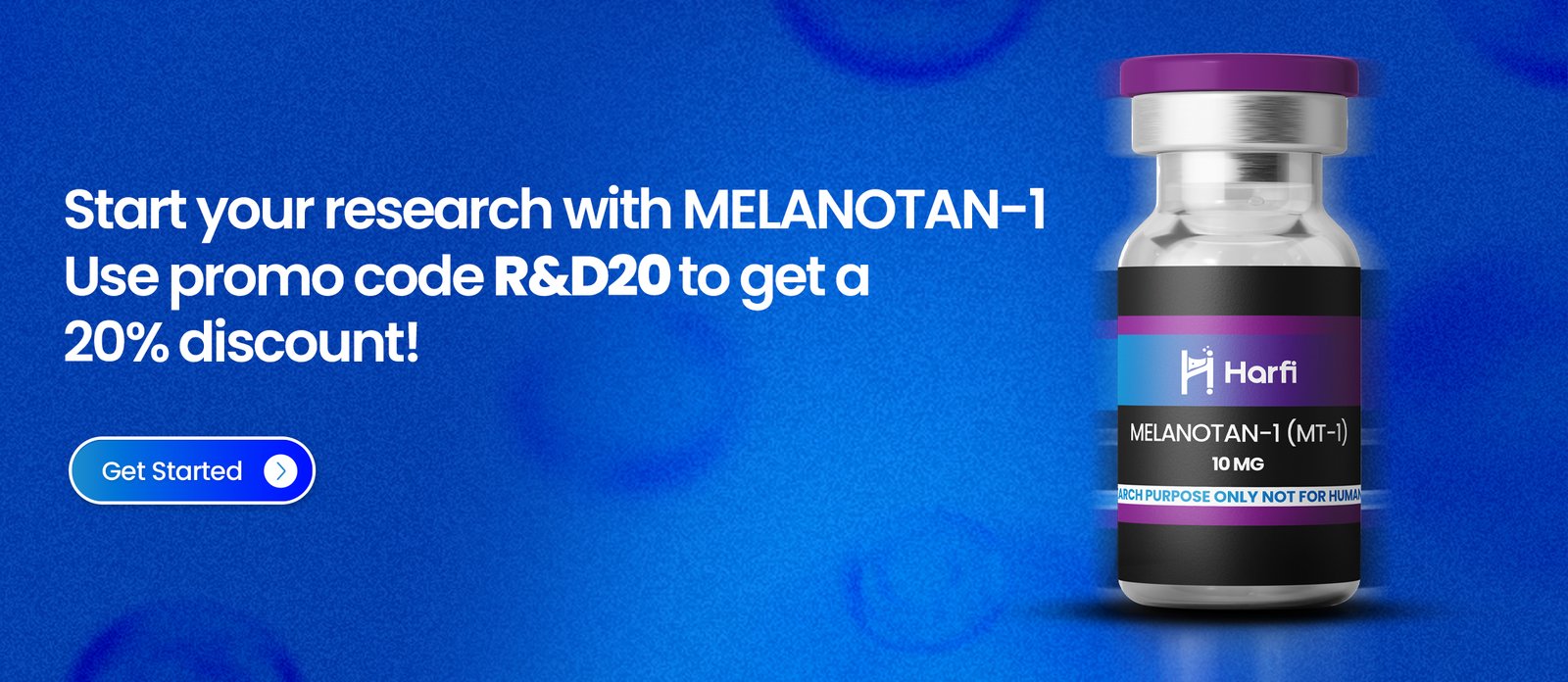Melanotan-1 (MT-1)
Melanotan 1 (MT1) closely resembles the naturally occurring alpha-melanocyte-stimulating hormone (alpha-MSH), also known as Melanotan 2. Alpha-MSH plays a key role in pigmentation by stimulating melanocytes, the cells responsible for skin and hair color, through strong binding to melanocortin receptor 1. As a non-selective full agonist, alpha-MSH also interacts with melanocortin receptors 1, 3, 4, and 5.
Melanotan 1 differs from alpha-MSH (Melanotan 2) by a single amino acid and was initially developed as a sunless tanning agent. During research into melanocortin receptors, scientists discovered that while Melanotan 1 effectively enhanced pigmentation, it also influenced baseline metabolism. Further studies on Melanotan 1 and other melanocortin-binding proteins have significantly advanced the understanding of the melanocortin signaling system.
Product Usage
This product is intended for research purposes only. It is strictly designated for in vitro testing and laboratory experimentation. All information provided on this website is for educational purposes only. Any introduction into humans or animals is strictly prohibited by law. Only licensed, qualified professionals should handle this product. It is not a drug, food, or cosmetic and must not be misbranded, misused, or mislabeled as such.
What Is Melanotan 1?
Melanotan 1 is a synthetic analogue of alpha-melanocyte-stimulating hormone (alpha-MSH). Clinically, it is used in Europe to prevent sun-related skin damage (phototoxicity) in individuals with erythropoietic protoporphyria. Although originally developed as a sunless tanning agent, researchers have discovered that Melanotan 1 also affects blood pressure, appetite regulation, central nervous system function, and more. Currently, the peptide is undergoing phase 3 clinical trials for the treatment of polymorphic light eruption and phase 2 trials for actinic keratosis—a sun-induced skin condition—and its more severe progression, squamous cell carcinoma.
Melanotan 1 Structure

Source: PubChem
Sequence: Ser-Tyr-Ser-Nle-Glu-His-D-Phe-Arg-Trp-Gly-Lys-Pro-Val
Molecular Formula: C78H111N21O19
Molecular Weight: 1646.874 g/mol
PubChem CID: 16154396
CAS Number: 75921-69-6
Synonyms: Afamelanotide, Scenesse, CUV1657, MT-1
How Does Melanotan 1 Work?
Melanotan 1 closely resembles alpha-melanocyte-stimulating hormone (alpha-MSH), a naturally occurring peptide known for its role in regulating skin and hair pigmentation. This process occurs through its strong binding to melanocortin receptor 1. Alpha-MSH acts as a full agonist for melanocortin receptors 1, 3, 4, and 5, influencing various physiological functions.
Melanotan 1 differs from alpha-MSH by just a single amino acid and was initially developed as a sunless tanning agent. At the time of its discovery, research on melanocortin receptors was limited. However, scientists soon found that, in addition to promoting pigmentation, Melanotan 1 also enhanced sexual arousal, increased appetite, and influenced metabolic activity. These findings led to further research, deepening the understanding of melanocortin signaling and its broader physiological effects.
Melanotan 1 Research
Melanotan 1: A Breakthrough in Sunless Tanning
Melanotan 1 (MT-1) has undergone Phase 1 clinical trials to evaluate its tanning effects in individuals exposed to ultraviolet (UV) radiation. Findings revealed that participants who received MT-1 were 75% more likely to tan and had a 47% lower risk of sunburn. Compared to the control group, these subjects required 50% less UV exposure to achieve the same tanning results and retained their tan for three weeks longer.
Researchers suggest that melanotan 1 could enhance tanning in high UV environments, offering protection against sunburn and long-term UV-induced skin damage. This could be particularly beneficial for individuals with poor tanning capabilities, classified as skin types I and II on the Fitzpatrick scale.
Studies on individuals with variant MC1 receptors indicate that melanotan 1 significantly increases melanin production, improving tanning and photoprotection. Since these individuals derive minimal benefit from sunscreen and must strictly limit sun exposure to prevent skin cancer, MT-1 research holds potential for advancing UV protection and reducing skin cancer risks.
Potential Role in Vitiligo Treatment
Melanotan 1 is also being explored for vitiligo treatment. A small Phase 1 trial combining MT-1 with UVB therapy demonstrated enhanced melanin production and melanocyte proliferation. Nearly half of the patients experienced improved pigmentation and a faster repigmentation rate. Researchers believe combining melanotan 1 with existing vitiligo treatments could yield synergistic effects, leading to improved aesthetic results in shorter timeframes. Additionally, MT-1 may hold promise for treating hypopigmented scars and similar skin conditions.
Actinic Keratosis and Skin Cancer Prevention
Actinic keratosis (AK), a scaly skin growth caused by excessive UV exposure, is a precancerous lesion that can progress to squamous cell carcinoma if untreated. While noticeable lesions can be removed, many remain undetectable. Melanotan 1 is being investigated as a potential first-line treatment to address these invisible lesions and prevent their progression to skin cancer.
Blood Pressure Regulation
Research on hypertensive mice suggests that melanotan 1 may lower high blood pressure without affecting normal blood pressure levels. Unlike conventional antihypertensive medications, which can lead to hypotension and associated risks such as fainting, stroke, or heart attack, MT-1 provides a promising alternative for safe and effective blood pressure regulation, particularly in elderly patients with unstable physiology.
Cognitive Benefits and Alzheimer’s Disease
Studies on transgenic mice indicate that melanotan 1 may protect against cognitive decline and Alzheimer’s disease. Even in minimal doses, MT-1 reduces amyloid beta plaques, prevents neuron death, and enhances synaptic transmission. Blocking its effects at the MC4 receptor eliminates these benefits, highlighting its crucial role in neuroprotection.
Additional studies suggest that MC4 receptor activation promotes neurogenesis and cognitive recovery in Alzheimer’s models. Unlike most treatments that merely slow disease progression, MT-1 has shown the ability to improve cognitive function. Once-daily administration significantly reduces Alzheimer’s-related biomarkers, suggesting a multifaceted therapeutic effect.
The MC4 receptor, found on astrocytes—the brain’s supportive cells—plays a vital role in neuron health. Research in rats demonstrates that melanotan 1 increases brain-derived neurotrophic factor (BDNF) levels, which are essential for synaptic stability and neurogenesis.
Post-Stroke Recovery
Studies on gerbil models of prolonged strokes reveal that administering melanotan 1 even nine hours post-stroke reduces brain damage, prevents neuron death, and improves memory and learning. Researchers believe MT-1 facilitates functional recovery by enhancing synaptic plasticity and rerouting cognitive functions to healthier brain areas. These effects are linked to increased expression of the Zif268 gene, which is also overexpressed in Alzheimer’s models showing cognitive improvements.
Cardiac Protection and Circulatory Benefits
In studies on rats undergoing heart attacks, melanotan 1 has demonstrated significant cardiovascular benefits. Administering MT-1 alongside epinephrine during cardiopulmonary resuscitation (CPR) stabilizes arterial pressure and heart rate, mitigates metabolic acidosis, reduces inflammation, and enhances cardiac function. These effects contribute to an 81% increase in survival rates, suggesting MT-1’s potential as a valuable addition to emergency cardiac care.
Neuroinflammatory Disease Research
Originally thought to regulate pigmentation, the MC1 receptor has been found to play a role in central nervous system inflammation. In mouse models of multiple sclerosis, melanotan 1 prevents myelin loss and neuronal damage by modulating T-cell activity. Additionally, MT-1 administration promotes myelin recovery and restores neuron signaling, suggesting therapeutic potential for demyelinating diseases.
Similarly, in models of uveitis—an inflammatory eye condition causing pain and vision loss—melanotan 1 suppresses T-cell function via the MC4 receptor, mimicking the effects of alpha-MSH. Localized administration to the eye has proven as effective as systemic administration, offering a promising alternative to steroids and immunosuppressants with fewer systemic side effects.
Fat Metabolism and Weight Management
Melanotan 1 interacts with multiple melanocortin receptors, including MC5R, which plays a crucial role in fat metabolism. Research in mice indicates that MC5R stimulation enhances fatty acid oxidation in muscles and shifts fat cells from storage to burning mode. These findings suggest melanotan 1’s potential as a tool for modulating fat metabolism, particularly for individuals unable to exercise due to obesity, disability, or injury.
Conclusion
Melanotan 1 continues to be a subject of extensive research due to its diverse therapeutic potential. From enhancing tanning and skin protection to treating vitiligo, regulating blood pressure, supporting cognitive function, aiding stroke recovery, improving cardiac outcomes, and modulating fat metabolism, MT-1 presents a promising avenue for future medical applications. Further studies are necessary to fully understand its mechanisms and clinical viability.
DISCLAIMER: FOR INFORMATIONAL AND EDUCATIONAL PURPOSES ONLY
All articles and product details provided on this website are strictly for informational and educational purposes.
The product information presented here applies solely to in-vitro studies—experiments conducted outside of living organisms, such as in laboratory settings. These products are not classified as medicines or drugs and have not been approved by the FDA for the prevention, treatment, or cure of any medical conditions, ailments, or diseases.
Furthermore, the use of these products in humans or animals is strictly prohibited by law.

